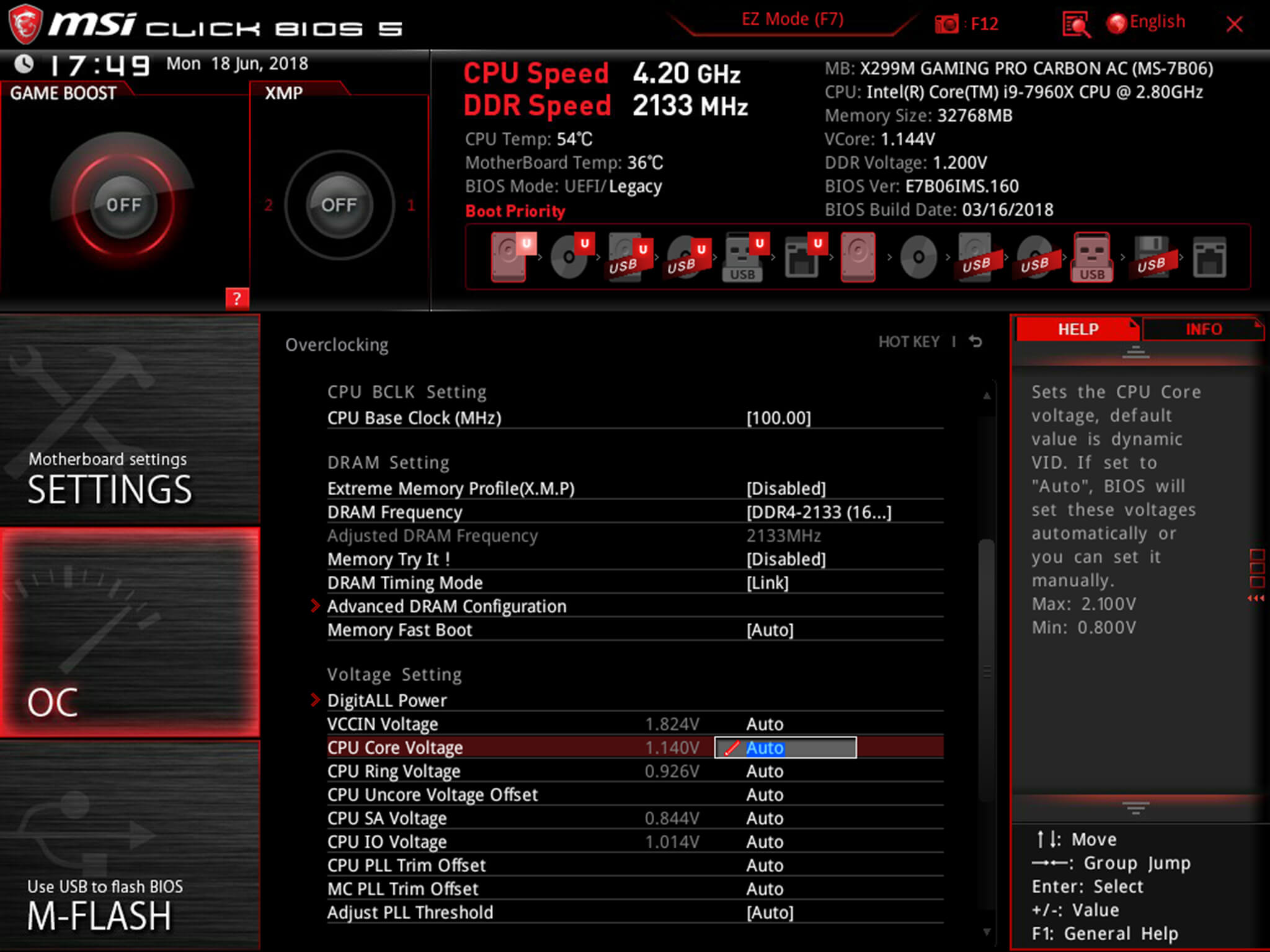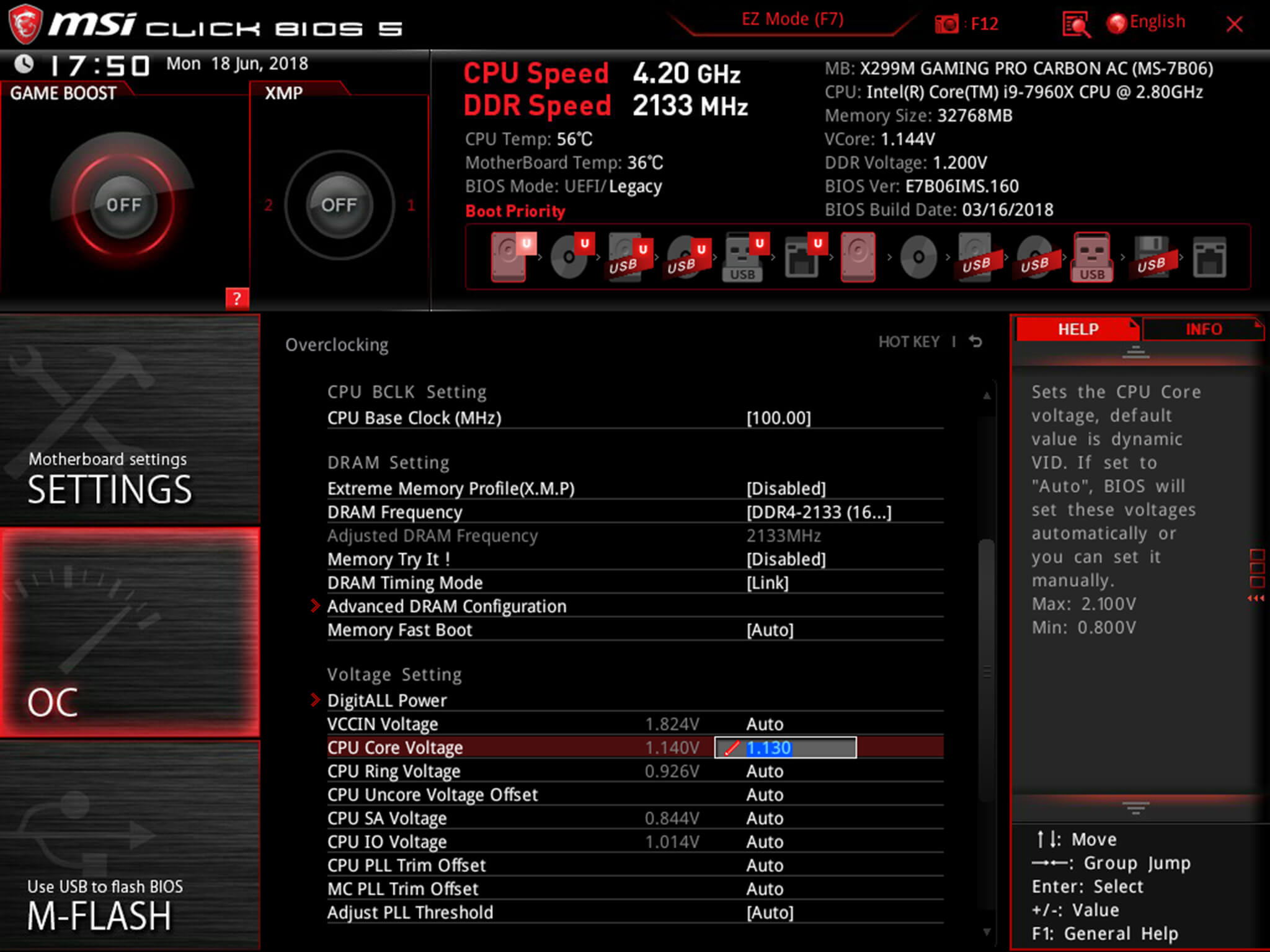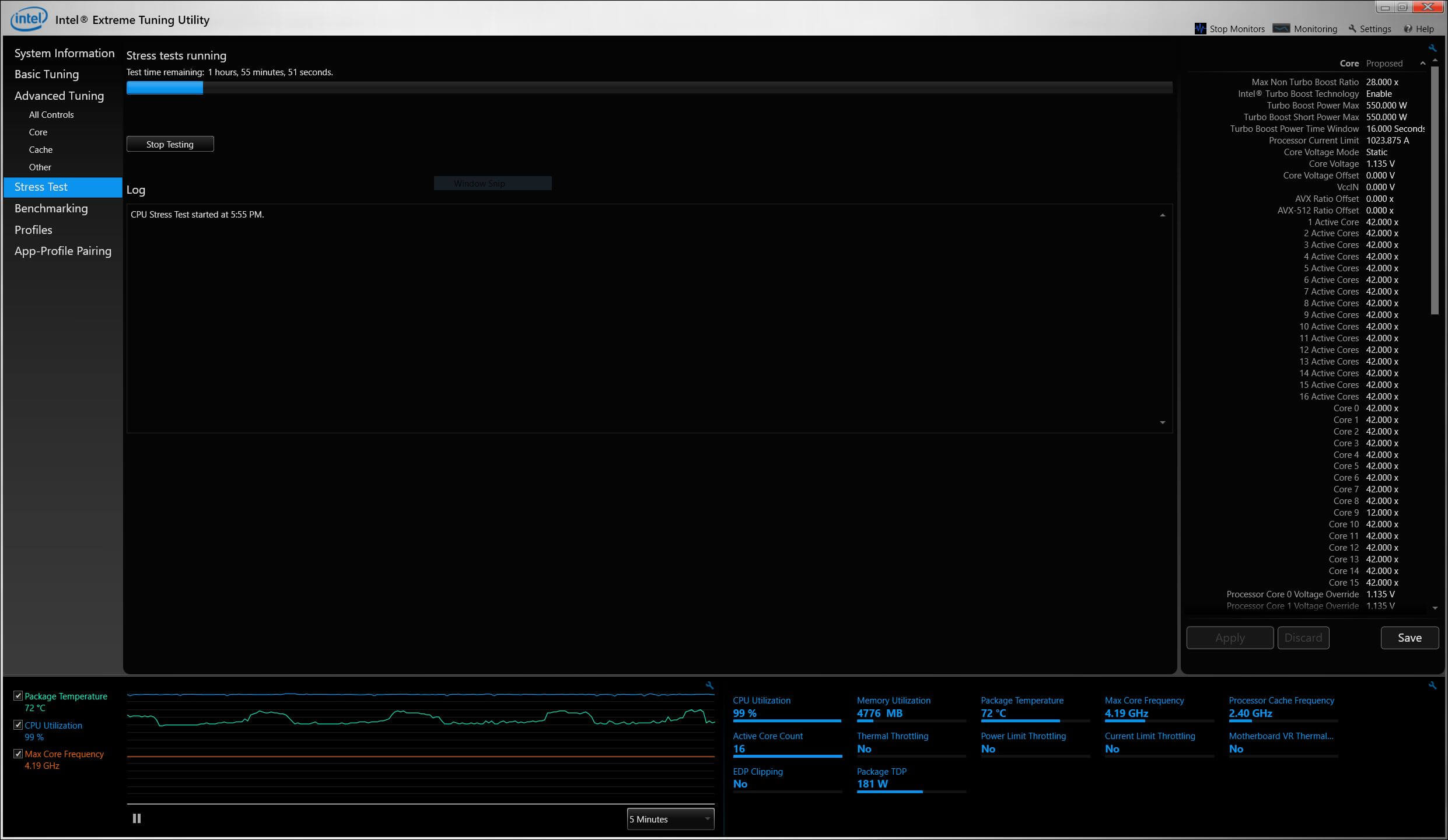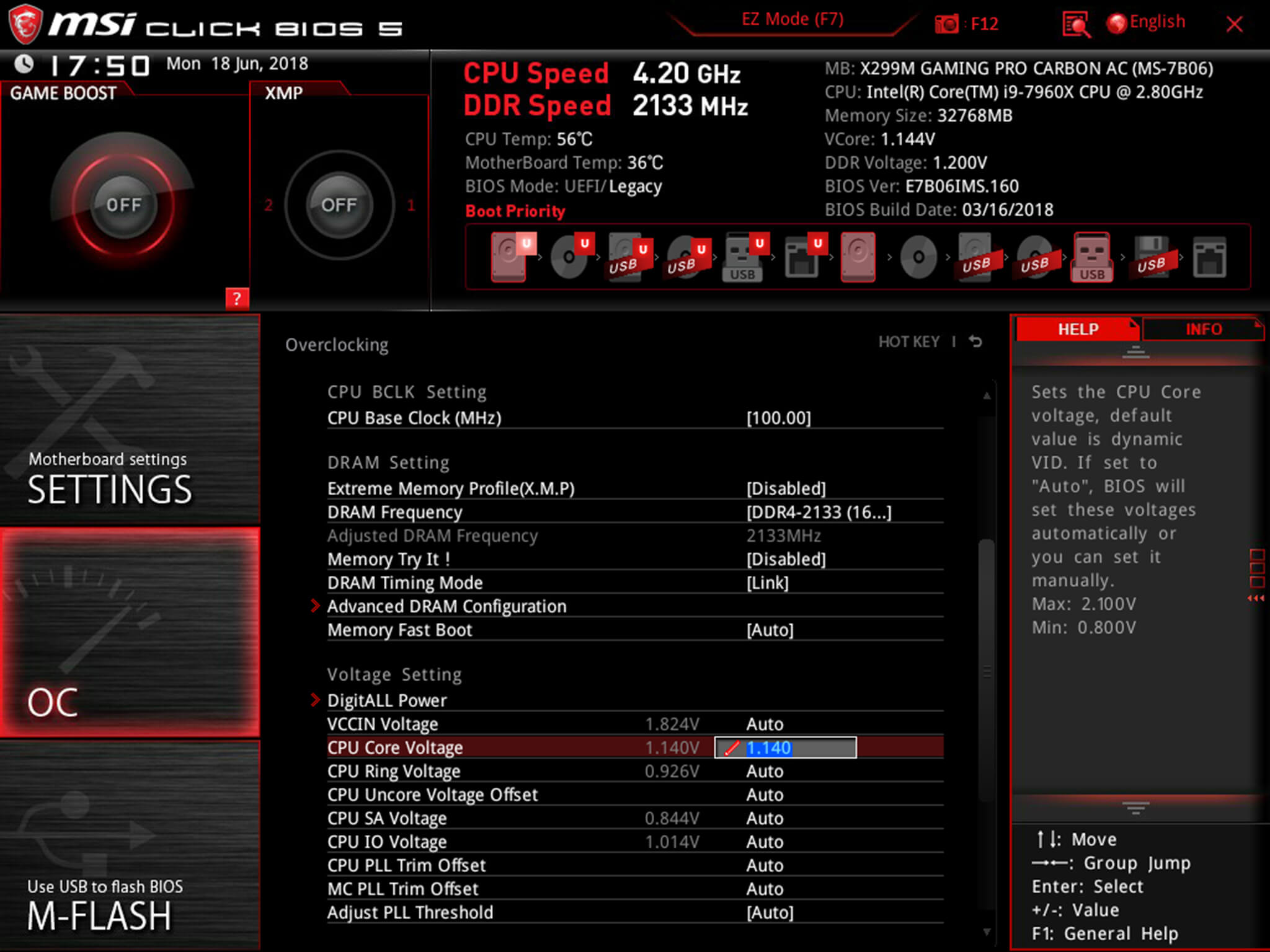The core voltage is different for each processor model, and while all CPUs of the same model have the same VID, not all samples maintain stability at the same clock speeds and Vcore due to slight variations in silicon quality. Every sample of the same CPU model is tested to maintain stability at the default speeds and the VID determined by the manufacturer.
Core voltage typically maintains a constant value while your CPU is in use; however, sometimes under heavy workloads vcore can fluctuate. This is known as Vdroop and can be corrected with load-line calibration. This applies additional voltage as load increases to maintain your CPU's stability.
When it comes to overclocking, you can only push your CPU's frequency so far before your CPU starts to experience instability. Programs might begin to crash or hang up, game performance could suffer or your computer could even fail to boot. This is because your processor isn't getting enough voltage to maintain system stability.
Increasing voltage will allow you to dial in the perfect overclock.
To adjust the voltage, you'll need to boot into your motherboard's BIOS and make adjustments there. The Vcore is expressed as a three decimal value, such as 1.235v. By default, the voltage control is set to auto; this can be overridden by typing in any value. Make sure not to exceed the recommended maximum for your processor.

Before fine-tuning the Vcore, it's important to find a good baseline value for a given speed. This varies from model to model but it can be helpful to read reviews for your CPU, specifically ones that focus on overclocking.
Most publications will list the voltage they required to keep several different speeds stable. Every CPU sample is different and you will need to fine-tune the voltage before calling it done; however, these values do provide a good starting point.

If you boot your machine and don't find any stability issues, then you know it's time to start decreasing the voltage. When overclocking, you want to find the lowest voltage required to maintain stability. More voltage equals more heat and this will allow you to keep temperatures under control.

The safest way to adjust voltage is with increments of .01 volts. Decrease voltage until your computer starts showing signs of instability under load. Use a program like Intel's Extreme Tuning Utility (XTU) or Prime95 to stress test your processor.
If the test fails or crashes, then you need to raise the voltage back up to the previous stable point. For optimal efficiency, you can increase the voltage by .005 instead and again test for stability.

Conversely, if your overclock isn't stable at your baseline voltage, you will then need to increase the voltage until your computer shows no adverse effects and then decrease in increments of .005 to fine tune.

Overclocking is not the only time it can be useful to adjust voltage. As mentioned, higher voltage levels cause your CPU to generate more heat, regardless of frequency. Some CPU samples may have a higher VID than is actually required at the default frequency. Undervolting your processor allows your to maintain stability while decreasing temperatures and extending the life of your processor.
It's a common misconception that disabling Turbo Boost is a more effective substitute for shedding heat. While this does result in decreased temperatures, it is not an alternative as the purpose of undervolting is to maintain the same level of performance while generating less heat. When making adjustments, the same principles apply here as with overclocking, decrease Vcore in increments of .01 and then fine tune with adjustments of .005.
 SpaceX's BFR has a new name. Elon Musk is calling it Starship.
SpaceX's BFR has a new name. Elon Musk is calling it Starship.
 HBO Max’s ‘Love Life’ justifies its existence in Season 2
HBO Max’s ‘Love Life’ justifies its existence in Season 2
 HHS removes key lesbian and bisexual women's health info from site
HHS removes key lesbian and bisexual women's health info from site
 What is a VPN Router?
What is a VPN Router?
 Best Max streaming deal: Save 20% on annual subscriptions
Best Max streaming deal: Save 20% on annual subscriptions
 Everyone could have won 'Squid Game' hopscotch, and that's just bad game design
Everyone could have won 'Squid Game' hopscotch, and that's just bad game design
 You can now move your WhatsApp chat history from iPhone to Android (but there's a catch)
You can now move your WhatsApp chat history from iPhone to Android (but there's a catch)
 This kangaroo just wants to touch a golf flag and who can blame him
This kangaroo just wants to touch a golf flag and who can blame him
 Best Apple TV+ deal: Get 3 months for $2.99 monthly
Best Apple TV+ deal: Get 3 months for $2.99 monthly
 Jeff Sessions controls what happens to Martin Shkreli's Wu
Jeff Sessions controls what happens to Martin Shkreli's Wu
 Uber lands 50,000 Tesla cars for drivers to rent in the U.S.
Uber lands 50,000 Tesla cars for drivers to rent in the U.S.
 Trump gets 'DO NOT CONGRATULATE' Putin note from advisor. Then he did.
Trump gets 'DO NOT CONGRATULATE' Putin note from advisor. Then he did.
 Everything coming to Amazon Prime Video in November
Everything coming to Amazon Prime Video in November
 'Dune: Part Two' is officially happening
'Dune: Part Two' is officially happening
 Everything coming to Amazon Prime Video in November
Everything coming to Amazon Prime Video in November
 Donald Trump tweets about wanting to beat up Joe Biden
Donald Trump tweets about wanting to beat up Joe Biden
 Best Max streaming deal: Save 20% on annual subscriptions
Best Max streaming deal: Save 20% on annual subscriptions
 This kangaroo just wants to touch a golf flag and who can blame him
This kangaroo just wants to touch a golf flag and who can blame him
Best Bose deal: Save $70 on SoundLink Revolve+ (Series II)Best bicycle deals: Save up to 40% on bicycles at REIStuff Your Kindle Day: How to get free open door romance books on March 4World's largest call center using AI to 'neutralize' Indian employees' accentsHow to seek an abortion while protecting your digital privacyOscars honors Quincy Jones with lively performance of 'Ease On Down the Road'NYT Strands hints, answers for March 3Webb telescope zooms in on object freeBest charger deal: Get 40% off the Anker 9Is 'Anora' streaming?: How to watch the Best Picture winnerBest bicycle deals: Save up to 40% on bicycles at REIManchester United vs. Fulham 2025 livestream: Watch FA Cup for freeTecno reveals world's thinnest smartphoneIndia vs. Australia 2025 livestream: Watch ICC Champions Trophy for freeTesla Cybertruck at New Orleans' Mardi Gras parade gets mercilessly booed'Paradise's twisty ending, explained: Who killed Cal?Best laptop deal: Save $105 on the ASUS Vivobook S 14Watch BLACKPINK's Lisa, Doja Cat, and RAYE transform into Bond Girls at the 2025 Oscars'Tony Hawk's Pro Skater 3 + 4' gets July release dateBest robot vacuum deal: Save $400 on the roborock Q5 Pro+ Queen Cersei strikes down Donald Trump with 1 thunderous tweet Google releases Android Home Developers Preview, an IoT platform Massive crush of thousands of soccer fans looks like a total nightmare The Arctic is reeling from its warmest year since at least 1900 The 10 most devastating TV moments of 2016 Taco Bell rings continues the confusing fast food jewelry trend The Chuck E. Cheese Challenge will make you nostalgic for ball pits This street performer dancing to the BBC news jingle is simply glorious Twitter suspends account lobbying against black deaths in police custody After long delay Apple's AirPods are finally on sale 'Rogue One' review: The Force is with this one, and it is amazing Finally there's proof that Britain's 4G is as bad as you thought Mitú launches Snapchat Discover channel Hundreds of tech workers pledge to fight a Muslim registry Here are all the new Pokémon you can get in 'Pokémon Go' One dad was so confused by 'Pokémon Go' he made a short film about it Watch LeBron James geek out to Kendrick Lamar in an utterly lifeless crowd Edward Snowden asks Twitter CEO to bring us tweet editing Nigerian bobsled team hopes to make a push at history Satanic Temple stands up to Ohio's heartbeat bill
2.6404s , 10133.34375 kb
Copyright © 2025 Powered by 【Puri for Rent (2025)】,Information Information Network